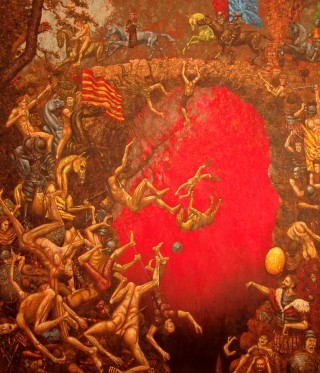JP Munro
19 Jan - 23 Feb 2008
JP MUNRO
For his third show at Sadie Coles HQ, American artist JP Munro presents an ambitious collection of new paintings. In his work, Munro reinterprets myths and legends, many of which have been previously realised by canonical artists such as Titian, Delacroix, and Moreau.
With epic overtones and elaborate costumes, Munro’s work is often spoken about in terms of the cinematic, more specifically film posters, at once telling all and none of the story. Film posters possess a ceremonial air that find echo in the intensity of detail and complexity of composition found in Munro’s works.
Endowed with a distinctively contemporary edge, Munro’s paintings border on pastiche, and it quickly becomes apparent that, although of undeniable interest, it is not so much the subject matter composed of derivative themes that counts, but rather how it provides, in the artist’s own words, ‘a way into moving coloured pigment around.’
Thematically, Munro’s new pieces do not mark a significant departure, but rather there is a shift in his use of colour. His palette here is darker, richer, and while the works depict episodes that have taken place across various centuries and continents, they are aesthetically unified by tone. The fiery reds applied in the Battle of Cadore accentuate the scene’s gritty violence and durable presence and it is exemplary of the way in which the artist works. Taking a painting by Italian Renaissance painter Titian entitled The Battle of Spoleto that was lost in a fire in 1577, Munro, intrigued by the idea of ‘a battle on a bridge’, fuses elements of Titian’s own drawings with copies of the painting by the Old Master’s contemporaries as well as his own personal impressions. Incredibly congested, this panorama contrasts with his depiction of the Biblical story the Temple of Solomon. Munro shows Israel’s first house of the Lord as a depleted yet affluent place with a gold interior archway and ornate surroundings. Starting with visual symbols from freemasonic structures the artist then combines them with knowledge from archive drawings and diagrams, to create an ominous yet enticing entrance. Meanwhile Heracles in the Garden of the Hesperides captures the moment before Heracles is to slain the serpent. The scene beholds an overall feeling of stillness and containment and yet is still ill at ease as all four Hesperides are turned towards Heracles aghast at what will happen next.
JP Munro was born in 1975 in Inglewood, California. He lives in Los Angeles, California. His work has been exhibited widely including as part of the Whitney Biennial 2006: Day for Night, New York, and at the ICA, London, 2004.
For his third show at Sadie Coles HQ, American artist JP Munro presents an ambitious collection of new paintings. In his work, Munro reinterprets myths and legends, many of which have been previously realised by canonical artists such as Titian, Delacroix, and Moreau.
With epic overtones and elaborate costumes, Munro’s work is often spoken about in terms of the cinematic, more specifically film posters, at once telling all and none of the story. Film posters possess a ceremonial air that find echo in the intensity of detail and complexity of composition found in Munro’s works.
Endowed with a distinctively contemporary edge, Munro’s paintings border on pastiche, and it quickly becomes apparent that, although of undeniable interest, it is not so much the subject matter composed of derivative themes that counts, but rather how it provides, in the artist’s own words, ‘a way into moving coloured pigment around.’
Thematically, Munro’s new pieces do not mark a significant departure, but rather there is a shift in his use of colour. His palette here is darker, richer, and while the works depict episodes that have taken place across various centuries and continents, they are aesthetically unified by tone. The fiery reds applied in the Battle of Cadore accentuate the scene’s gritty violence and durable presence and it is exemplary of the way in which the artist works. Taking a painting by Italian Renaissance painter Titian entitled The Battle of Spoleto that was lost in a fire in 1577, Munro, intrigued by the idea of ‘a battle on a bridge’, fuses elements of Titian’s own drawings with copies of the painting by the Old Master’s contemporaries as well as his own personal impressions. Incredibly congested, this panorama contrasts with his depiction of the Biblical story the Temple of Solomon. Munro shows Israel’s first house of the Lord as a depleted yet affluent place with a gold interior archway and ornate surroundings. Starting with visual symbols from freemasonic structures the artist then combines them with knowledge from archive drawings and diagrams, to create an ominous yet enticing entrance. Meanwhile Heracles in the Garden of the Hesperides captures the moment before Heracles is to slain the serpent. The scene beholds an overall feeling of stillness and containment and yet is still ill at ease as all four Hesperides are turned towards Heracles aghast at what will happen next.
JP Munro was born in 1975 in Inglewood, California. He lives in Los Angeles, California. His work has been exhibited widely including as part of the Whitney Biennial 2006: Day for Night, New York, and at the ICA, London, 2004.

